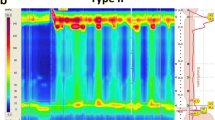Abstract
There is a subgroup of patients with achalasia in which manometry shows elevated intraesophageal pressure, expressed by elevation of esophageal baseline relative to gastric pressure. The aim of this study was to determine the prevalence of elevated intraesophageal pressure in patients with achalasia and its relationship to clinical, radiographic, endoscopic, and other manometric findings. Manometric studies of 62 patients with achalasia were analyzed and elevated intraesophageal pressure was considered any positive elevation of esophageal baseline relative to gastric pressure. Multiple regression analysis was used to determine independent risk factors associated with elevated intraesophageal pressure. Elevated intraesophageal pressure was found in 32 patients (51.6%). Lower esophageal sphincter pressure was the only independent variable associated with elevated intraesophageal pressure (P = 0.0167). Mean lower esophageal sphincter pressure was significantly higher in patients with elevated compared to those with normal intraesophageal pressure (34 ± 1.96 vs 26.5 ± 1.73 mm Hg; P = 0.006). In addition, lower esophageal sphincter pressure had a positive correlation with intraesophageal pressure (r = 0.49, P < 0.001). Conversely, no correlation was found between elevated intraesophageal pressure and various symptoms, disease duration, radiologic dilation, a finding of retained fluid during endoscopy, and esophageal length. We conclude that elevated intraesophageal pressure is a common manometric finding in patients with achalasia, with a prevalence of 51.6%, and is associated with significantly higher lower esophageal sphincter pressure.
Similar content being viewed by others
References
Wong RKH, Maydonovitch CL: Achalasia. In the Esophagus, 3rd ed. DO Castell, JE Richter (eds). Philadelphia, Lippincott Williams and Wilkins, 1999, pp 185-213
Vaezi MF, Richter JE: Diagnosis and management of achalasia. Am J Gastroenterol 94: 3406-3412, 1999
Trashinsky MB, Castell DO: Achalasia. In Esophageal Motility Testing, 2nd ed. DO Castell, JA Castell (eds). Norwalk, CT Appleton and Lange, 1994, pp 109-121
Barlow JD, Buckton GK: The esophageal body: procedures and analysis. In Clinical Measurement in Gastroenterology, Vol 1. The Oesophagus. DF Evans, GK Buckton (eds). Oxford, UK, Blackwell Science, 1997, pp 50-74
Mittal RK, Siskind BN, Hongo M, Flye MW, McCallum RW: Dysphagia aortica: clinical, radiological and manometric findings. Dig Dis Sci 31:379-384, 1986
Cappell MS: Manometric findings in dysphagia secondary to left atrial dilatation. Dig Dis Sci 36:693-698, 1991
Stagias JG, Ciarolla D, Campo S, Burrell MI, Traube M: Vascular compression of the esophagus: a manometric and radiologic study. Dig Dis Sci 39:782-786, 1994
Cappell MS: Endoscopic, radiographic and manometric findings associated with cardiovascular dysphagia. Dig Dis Sci 40:166-176, 1995
Katz PO, Richter JE, Cowan R, Castell DO: Apparent complete lower esophageal sphincter relaxation in achalasia. Gastroenterology 90:978-983, 1986
Vantrappen G, Janssens J, Hellemans J, Coremans G: Achalasia, diffuse esophageal spasm, and related motility disorders. Gastroenterology 76:450-457, 1979
Bielefeldt K, Enck P, Erckenbrecht JF: Motility changes in primary achalasia following pneumatic dilation. Dysphagia 5:152-158, 1990
Bianco A, Cogossi M, Scrimieri D, Greco AV: Appearance of esophageal peristalsis in treated idiopathic achalasia. Dig Dis Sci 31:40-48, 1986
Hirano I, Tatum RP, Shi G, Sang Q, Joehl RJ, Kahrilas PJ: Manometric heterogeneity in patients with idiopathic achalasia. Gastroenterology 120:789-798, 2001
Goldblum JR, Rice TW, Richter JE: Histopathologic features in esophagomyotomy specimens from patients with achalasia. Gastroenterology 111:648-654, 1996
Zhang ZG, Diamant NE: Repetitive contractions of the upper esophageal body and sphincter in achalasia. Dysphagia 9: 12-19, 1994
Author information
Authors and Affiliations
Corresponding author
Rights and permissions
About this article
Cite this article
Kamberoglou, D.K., Zambeli, E.P., Triantafyllopoulos, P.A. et al. Elevated Intraesophageal Pressure in Patients with Achalasia: A Common and Important Manometric Finding. Dig Dis Sci 48, 2242–2246 (2003). https://doi.org/10.1023/B:DDAS.0000007858.31353.00
Issue Date:
DOI: https://doi.org/10.1023/B:DDAS.0000007858.31353.00




